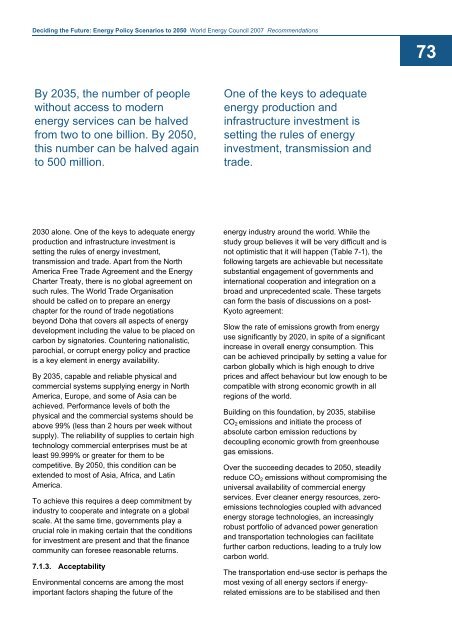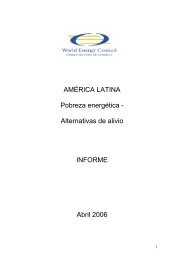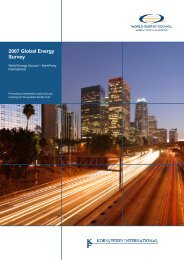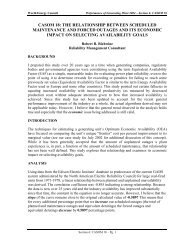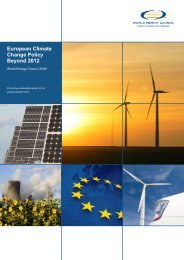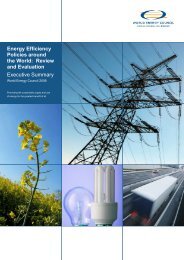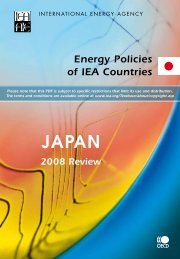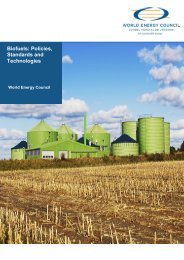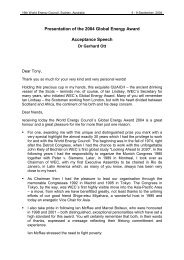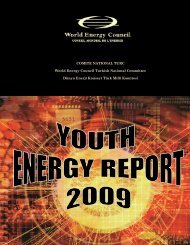Deciding the Future: Energy Policy Scenarios to 2050
Deciding the Future: Energy Policy Scenarios to 2050
Deciding the Future: Energy Policy Scenarios to 2050
Create successful ePaper yourself
Turn your PDF publications into a flip-book with our unique Google optimized e-Paper software.
<strong>Deciding</strong> <strong>the</strong> <strong>Future</strong>: <strong>Energy</strong> <strong>Policy</strong> <strong>Scenarios</strong> <strong>to</strong> <strong>2050</strong> World <strong>Energy</strong> Council 2007 Recommendations<br />
73<br />
By 2035, <strong>the</strong> number of people<br />
without access <strong>to</strong> modern<br />
energy services can be halved<br />
from two <strong>to</strong> one billion. By <strong>2050</strong>,<br />
this number can be halved again<br />
<strong>to</strong> 500 million.<br />
One of <strong>the</strong> keys <strong>to</strong> adequate<br />
energy production and<br />
infrastructure investment is<br />
setting <strong>the</strong> rules of energy<br />
investment, transmission and<br />
trade.<br />
2030 alone. One of <strong>the</strong> keys <strong>to</strong> adequate energy<br />
production and infrastructure investment is<br />
setting <strong>the</strong> rules of energy investment,<br />
transmission and trade. Apart from <strong>the</strong> North<br />
America Free Trade Agreement and <strong>the</strong> <strong>Energy</strong><br />
Charter Treaty, <strong>the</strong>re is no global agreement on<br />
such rules. The World Trade Organisation<br />
should be called on <strong>to</strong> prepare an energy<br />
chapter for <strong>the</strong> round of trade negotiations<br />
beyond Doha that covers all aspects of energy<br />
development including <strong>the</strong> value <strong>to</strong> be placed on<br />
carbon by signa<strong>to</strong>ries. Countering nationalistic,<br />
parochial, or corrupt energy policy and practice<br />
is a key element in energy availability.<br />
By 2035, capable and reliable physical and<br />
commercial systems supplying energy in North<br />
America, Europe, and some of Asia can be<br />
achieved. Performance levels of both <strong>the</strong><br />
physical and <strong>the</strong> commercial systems should be<br />
above 99% (less than 2 hours per week without<br />
supply). The reliability of supplies <strong>to</strong> certain high<br />
technology commercial enterprises must be at<br />
least 99.999% or greater for <strong>the</strong>m <strong>to</strong> be<br />
competitive. By <strong>2050</strong>, this condition can be<br />
extended <strong>to</strong> most of Asia, Africa, and Latin<br />
America.<br />
To achieve this requires a deep commitment by<br />
industry <strong>to</strong> cooperate and integrate on a global<br />
scale. At <strong>the</strong> same time, governments play a<br />
crucial role in making certain that <strong>the</strong> conditions<br />
for investment are present and that <strong>the</strong> finance<br />
community can foresee reasonable returns.<br />
7.1.3. Acceptability<br />
Environmental concerns are among <strong>the</strong> most<br />
important fac<strong>to</strong>rs shaping <strong>the</strong> future of <strong>the</strong><br />
energy industry around <strong>the</strong> world. While <strong>the</strong><br />
study group believes it will be very difficult and is<br />
not optimistic that it will happen (Table 7-1), <strong>the</strong><br />
following targets are achievable but necessitate<br />
substantial engagement of governments and<br />
international cooperation and integration on a<br />
broad and unprecedented scale. These targets<br />
can form <strong>the</strong> basis of discussions on a post-<br />
Kyo<strong>to</strong> agreement:<br />
Slow <strong>the</strong> rate of emissions growth from energy<br />
use significantly by 2020, in spite of a significant<br />
increase in overall energy consumption. This<br />
can be achieved principally by setting a value for<br />
carbon globally which is high enough <strong>to</strong> drive<br />
prices and affect behaviour but low enough <strong>to</strong> be<br />
compatible with strong economic growth in all<br />
regions of <strong>the</strong> world.<br />
Building on this foundation, by 2035, stabilise<br />
CO 2 emissions and initiate <strong>the</strong> process of<br />
absolute carbon emission reductions by<br />
decoupling economic growth from greenhouse<br />
gas emissions.<br />
Over <strong>the</strong> succeeding decades <strong>to</strong> <strong>2050</strong>, steadily<br />
reduce CO 2 emissions without compromising <strong>the</strong><br />
universal availability of commercial energy<br />
services. Ever cleaner energy resources, zeroemissions<br />
technologies coupled with advanced<br />
energy s<strong>to</strong>rage technologies, an increasingly<br />
robust portfolio of advanced power generation<br />
and transportation technologies can facilitate<br />
fur<strong>the</strong>r carbon reductions, leading <strong>to</strong> a truly low<br />
carbon world.<br />
The transportation end-use sec<strong>to</strong>r is perhaps <strong>the</strong><br />
most vexing of all energy sec<strong>to</strong>rs if energyrelated<br />
emissions are <strong>to</strong> be stabilised and <strong>the</strong>n


